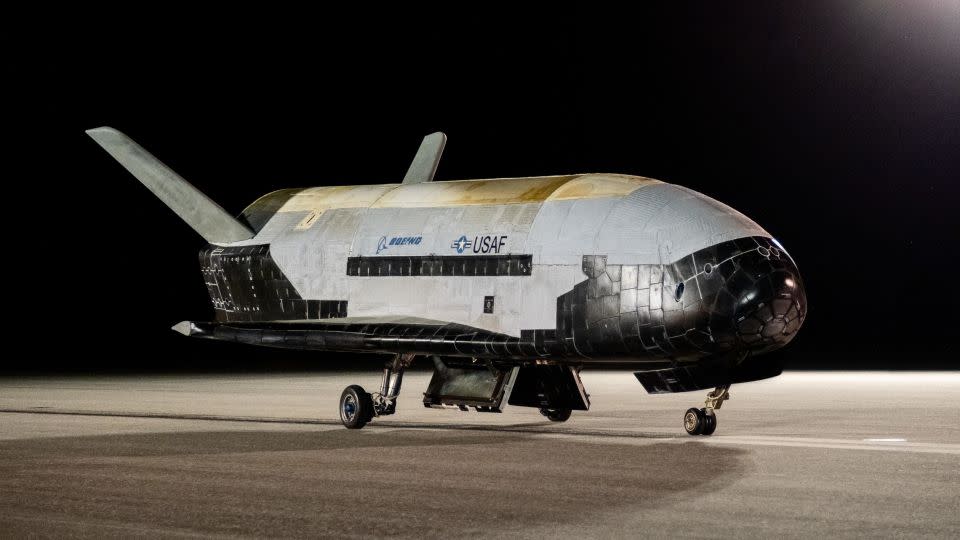SpaceX’s massive Falcon Heavy rocket will return to the skies on Thursday evening, this time launching a mysterious spacecraft that will conduct cutting-edge research for the US military.
The rocket is scheduled to lift off from NASA’s Kennedy Space Center in Florida at 8:07 p.m. ET, carrying the military’s uncrewed and autonomously operated X-37B spaceplane to unprecedented altitudes. The launch will be broadcast live on SpaceX’s website.
However, it is not clear exactly where the space plane is going.
The X-37B’s activities in space have long been the subject of fascination and speculation within the space community, as amateur enthusiasts race to track its whereabouts and share theories about its activities.
The reusable and fully autonomous X-37B, which resembles a miniature NASA space shuttle with darkened windows, is known to conduct research on concepts such as transferring solar energy from space to Earth and examining the effects of radiation on the seeds used. growing food.
And this mission, the seventh space journey of the X-37B aircraft, promises to be much more interesting than previous flights.

A powerful ride
This launch will mark the first time the spaceplane will hitch a ride aboard the SpaceX Falcon Heavy, one of the most powerful operational rockets in the world.
Previously, the X-37B was launched on a SpaceX Falcon 9 vehicle and an Atlas V rocket built by United Launch Alliance, a joint venture between Lockheed Martin and Boeing.
Falcon Heavy produces more thrust than these two rockets combined.
Paul Graziani, CEO of COMSPOC, a company dedicated to tracking objects in space, suggested that its launch aboard the Falcon Heavy could indicate the X-37B will go to more distant orbits, perhaps even to the Moon or Mars.
If it goes much deeper into the cosmos than previous flybys, it could be much harder for those looking at the skies on Earth to detect where the craft is.
Graziani added that if the military did not want people to follow the X-37B, the vehicle could be hidden in the sun or by a variety of other means, including changing its location frequently. The X-37B had already proven itself capable of multiple maneuvers in space in previous flights.
COMSPOC will attempt to search for the spacecraft if it enters geosynchronous orbit, which is about 22,400 miles (36,000 kilometers) from Earth and where most large communications satellites operate. Graziani and Bob Hall, COMSPOC’s director of operations integration, said geosynchronous orbit is where the company focuses its sensors to track satellites.
Graziani said of the X-37B launch: “I think it’s one of the most interesting things that’s happened in space in a long time, no matter what it does.”
Space technology innovations
According to a statement by Gen. B. Chance Saltzman, chief of space operations, the X-37B enables the United States to conduct experiments to understand how to improve ongoing and upcoming space operations and push the boundaries of what is possible.
Research on this mission includes a NASA experiment aimed at finding ways to sustain astronauts on future deep space missions. This vehicle, called Seeds-2, will “expose plant seeds to the harsh radiation environment of long-duration spaceflight” and will build on research conducted on previous X-37B missions.
Learning how to grow food in the harsh, soil-free environment of space could be crucial for astronauts on long missions to the moon or beyond, places where fresh supplies are more difficult to source.
It’s unclear how long the spacecraft will remain in orbit during this time, but historically each X-37B flight has lasted longer than the last.
The autonomous X-37B’s last journey into space ended in November 2022, after the spacecraft spent approximately 909 consecutive days in space. During this sixth mission, the spacecraft was carrying experimental technology designed by the US Navy to convert solar energy and transmit it back to the ground, according to the military, as CNN previously reported.
The X-37B has already spent more than 3,700 days in space on other uncrewed missions. When it returns to Earth, it will land on a runway, just like a plane hurtling down from the sky.
challenge china
This launch came after more than two weeks of delay. SpaceX was preparing to take off on December 10. The launch was delayed twice due to weather conditions and ground issues before SpaceX abruptly postponed the mission indefinitely to “conduct additional system checks.”
But during the outage, China, which the U.S. government sees as its chief rival in the modern space race, sent its own secret spacecraft into orbit.
Little is known about the spacecraft from China. Some in the industry consider it to be an analogue of the X-37B in form and function, but no official photos of the vehicle have been released.
China’s state-run Xinhua News Agency reported that the secret spacecraft was launched on a Long March 2F rocket.
During its stay in space, the vehicle will test reusable space technology and conduct unspecified scientific experiments “for the peaceful use of space,” the agency’s post said.
It is unclear how long China’s space plane will remain in orbit.
For more CNN news and newsletters, create an account at CNN.com